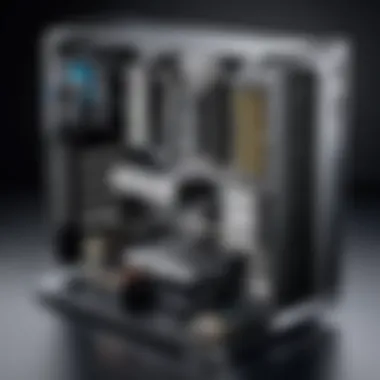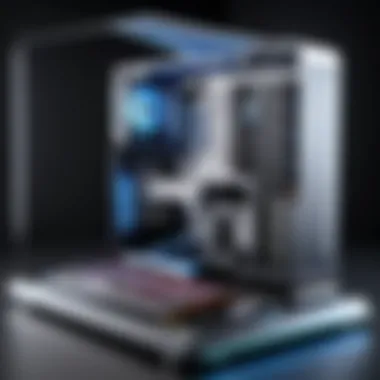Evaluating the Cost of a Gaming Computer: A Comprehensive Guide


Intro
The cost of a gaming computer can vary significantly depending on various factors. It is essential for both IT professionals and tech enthusiasts to comprehensively assess these elements before making a purchase. This article aims to provide detailed insights into hardware components, performance metrics, and budget considerations. Understanding these aspects can make it easier to find the right balance between cost, quality, and performance.
Hardware Overview
Specifications
When evaluating the cost of a gaming computer, the hardware specifications serve as the foundation for understanding its capabilities and performance. Key components to consider include the central processing unit (CPU), graphics processing unit (GPU), memory (RAM), and storage solutions such as solid-state drives (SSD) or hard disk drives (HDD).
- CPU: The choice of CPU impacts overall system performance. High-performance CPUs, such as Intel Core i9 or AMD Ryzen 9, command higher price points but deliver superior processing capabilities.
- GPU: The GPU is often the most critical component for gaming performance. High-end options like NVIDIA GeForce RTX 30 series or AMD Radeon RX 6000 series may be more expensive but offer excellent graphics rendering.
- RAM: A minimum of 16GB of RAM is recommended for gaming, but 32GB is ideal for future-proofing and multitasking.
- Storage: The cost varies based on storage type. SSDs provide faster load times and improved performance, while HDDs offer larger capacities at lower prices.
Performance Metrics
Evaluating performance metrics helps gauge the effectiveness of each component in delivering a smooth gaming experience. Several benchmarks can be useful in this assessment:
- Frame Rates: Higher frame rates are essential for smoother gameplay. Components that achieve frame rates above 60 fps are generally preferred for a more enjoyable experience.
- Load Times: Fast load times are achieved primarily through SSDs which can drastically reduce waiting time.
- Thermals: Managing thermal performance is crucial for maintaining hardware longevity. High-quality cooling solutions can prevent overheating.
"Defining performance metrics helps delineate the lines between acceptable and exceptional gaming experiences."
Software Analysis
Features and Functionality
The software running on a gaming computer plays an equally significant role in determining its overall value. The operating system, drivers, and gaming applications contribute to the software ecosystem. Windows remains the dominant OS due to its extensive support for games and applications. It is also necessary to consider the software features such as game optimization utilities, which enhance performance based on system parameters.
User Interface and Experience
A well-designed user interface (UI) can elevate the overall experience when navigating through games or applications. Intuitive controls and seamless interaction are aspects that should not be overlooked. Customizable settings allow gamers to adjust performance based on personal preferences, adding to the overall usability of the machine.
By understanding both hardware and software aspects, IT professionals and tech enthusiasts can make informed decisions about their gaming computer investments, ensuring a satisfactory blend of performance and cost.
Understanding Gaming Computer Costs
Evaluating the cost of a gaming computer involves examining a variety of factors. This is not just about the price tag attached to the components, but also understanding the performance expectations and future-proofing considerations. Gaming computers can vary widely in price, depending on the specifications selected. Therefore, a comprehensive understanding of these costs is crucial for IT professionals and tech enthusiasts.
The complexity of hardware selection plays a key role in shaping the overall cost. Each component, from the CPU to the graphics card, has its own price and performance characteristics. Evaluating these components requires insight into how they interact and affect gaming experiences.
Benefits of Understanding Costs
- Informed decision-making: Knowledge of hardware costs enables buyers to select the best components within their budget.
- Performance vs. price: Insight into cost structures aids in balancing performance and expenditure.
In addition to hardware choices, one must consider market dynamics influencing pricing. Seasonal sales, component shortages, or new product releases can all impact prices. This guide will help you understand these dynamics and how they affect your purchasing decision.
Finally, average price points for different configurations provide benchmarks. Knowing these averages helps set realistic expectations. Different setups cater to varying gaming needs, and this guide will break down expected costs for entry-level versus high-end systems.


Understanding gaming computer costs is not merely an academic exercise. It has real implications for purchasing, planning, and maintaining a gaming rig.
Components That Shape the Cost
Understanding the components that shape the cost of a gaming computer is crucial for making informed purchasing decisions. This section will explore the essential hardware elements and their impact on overall pricing. Each component plays a significant role in a system's performance, capability, and longevity. The more knowledge an individual has about these components, the better they can allocate their budget. Recognizing the function and importance of each part can aid in balancing performance against expense, ensuring that the final build meets both gaming and usage requirements without unnecessary financial strain.
Central Processing Unit (CPU)
The central processing unit (CPU) acts as the brain of the computer. It executes instructions, runs applications, and manages tasks. Choosing the right CPU influences not only gaming performance but also overall system efficiency. Popular CPU options include Intel Core and AMD Ryzen. The performance of a CPU is usually specified by its core count and clock speed. Higher numbers often translate to better multitasking capabilities and faster processing, but this also means a higher cost.
It is vital to find a CPU that complements the intended use of the gaming computer, whether for casual gaming or intensive tasks like streaming. Also, ensure compatibility with the motherboard, since not all CPUs fit into every socket.
Graphics Processing Unit (GPU)
The graphics processing unit (GPU) is arguably the most critical component influencing gaming performance. This element determines how images and videos are rendered, and it directly affects frame rates and visual fidelity. Brands like NVIDIA and AMD dominate the market, offering various models ranging from entry-level to high-end options.
High-performance GPUs are generally more expensive and are essential for gaming at higher resolutions and settings. Selecting a GPU necessitates understanding the balance between price and desired gaming experience. For example, a 4K gaming experience requires a much more powerful GPU than 1080p.
Memory Requirements (RAM)
Random Access Memory (RAM) is pivotal in determining how smoothly programs run on a computer. For gaming, a minimum of 16GB is often recommended for modern titles, while more demanding games may require 32GB or more. Increased RAM allows for better multitasking and greater performance under loads, reducing stutter and lag.
RAM type also plays a role in speed and performance. DDR4 is the current standard, but DDR5 is emerging, promising better speeds. As with other components, prices can vary significantly, depending on specifications and capacity.
Storage Solutions (HDD vs. SSD)
Storage options dramatically affect the performance and user experience of a gaming computer. Hard Disk Drives (HDD) offer larger capacities at lower prices but generally have slower read and write speeds. Solid State Drives (SSD), on the other hand, provide faster data transfer rates, resulting in quicker load times for games and applications.
Many users opt for a combination of both: an SSD for the operating system and essential applications, plus an HDD for additional storage. Evaluating storage needs against performance demands and budget constraints is vital in making the right choice.
Motherboard Selection
The motherboard acts as the backbone of the computer, connecting all components. Choosing a compatible motherboard involves considering the CPU socket, RAM slots, expansion slots, and overall feature set. High-end motherboards often come equipped with advanced features like enhanced connectivity options and robust power delivery systems.
Although it may seem that spending less on a motherboard is a wise choice, investing in a good quality one can prevent future issues, especially concerning upgrades. Consider the brand reputation, chipset, and necessary features, such as Wi-Fi connectivity or built-in sound cards.
Power Supply Unit (PSU)
The power supply unit (PSU) is often overlooked, yet it is crucial for system stability and performance. A quality PSU ensures all components receive the necessary power without risk of failure. Options vary in output, efficiency ratings (like 80 PLUS certifications), and modularity. A non-modular PSU can lead to cable clutter, while a fully modular option allows for better cable management.
Selecting a PSU that meets the power requirements of the entire build while offering reliability can save future headaches. A general rule of thumb is to choose a PSU that provides about 20% more wattage than required for system stability.
Cooling Systems and Cases
Effective cooling systems are essential for maintaining optimal performance during extended gaming sessions. Overheating can lead to throttling and reduced performance, impacting gameplay experience.
Air coolers are popular for ease of installation and cost-effectiveness. Liquid cooling systems offer superior performance but often come at a higher price.


Proper airflow in the computer case is also crucial. Cases vary in size and design, influencing the ease of building and cooling capabilities. Adequate case fans and space for additional cooling solutions can be beneficial for overall performance.
In summary, understanding these components helps not only in selecting the right hardware but also in budget management. Optimal performance often requires a careful selection of each part to ensure the system meets its intended use.
Entry-Level vs. High-End Systems
Understanding the distinction between entry-level and high-end gaming systems is critical for anyone looking to invest in a gaming computer. This section evaluates both categories, shedding light on their features, advantages, and considerations to help buyers make informed choices. Choosing the right system often depends on personal gaming preferences, budget constraints, and future upgrade possibilities. The dynamics between performance and cost become significant as one navigates through the options.
Defining Entry-Level Systems
Entry-level systems are often characterized by affordable hardware that meets the basic requirements of most games. Users who typically opt for these systems include casual gamers or those who are just venturing into PC gaming. Key specifications might include:
- CPU: Typically a budget-friendly processor such as the Intel Core i3 or AMD Ryzen 3, sufficient for entry-level gaming.
- GPU: A modest graphics card, often found in pre-built systems, like the NVIDIA GTX 1650 or AMD Radeon RX 550.
- RAM: Generally around 8 GB, which is adequate for lighter games and multitasking.
- Storage: A combination of a small SSD and larger HDD can offer a balance of speed and capacity.
The prices for entry-level systems can vary but are generally found in the range of $500 to $800. This price point is attractive for many gamers, aiming to find a balance between performance and spending.
Characteristics of High-End Gaming Computers
In contrast, high-end gaming computers are designed for serious gamers who demand superior performance. These systems usually feature:
- CPU: Advanced processors like the Intel Core i7 or AMD Ryzen 7, delivering excellent performance across demanding applications.
- GPU: High-performance GPUs such as the NVIDIA RTX 3080 or AMD RX 6800 XT, capable of handling 4K gaming.
- RAM: Larger memory options, often starting at 16 GB and going up to 32 GB, ensuring smooth performance for resource-intensive games.
- Storage: Predominantly SSDs, offering faster load times and increased storage efficiency.
Such systems generally start around $1,200 and can easily exceed $2,500, depending on the configuration and additional features like RGB lighting and premium cooling solutions.
Balancing Performance and Cost
Finding the right balance between performance and cost is crucial whether purchasing an entry-level or high-end system. Here are some points to consider:
- Identify Your Gaming Needs: Understand what games you plan to play and the required specifications. Casual games demand less; high-end titles require more form the hardware.
- Consider Future Upgrades: Investing in a system with upgrade potential can prolong the lifespan and relevance of your gaming setup. Entry-level systems may become limited over time.
- Cost-Effectiveness: Weighing the performance gain against financial outlay is vital. Does the upgrade justify the price? Sometimes, the incremental benefits do not match the additional costs.
"Investing wisely in gaming hardware requires an understanding of both current needs and future expectations."
Balancing these aspects will guide consumers in making decisions that reflect both immediate enjoyment and long-term satisfaction with their gaming experience. Individuals should evaluate their choices carefully, ensuring that their investment aligns with their gaming aspirations.
Budgeting for a Gaming Computer
Budgeting for a gaming computer is a critical step in the decision-making process. As the complexity of games and the expectations of gamers grow, having a clear financial strategy becomes essential. Setting an adequate budget influences the overall construction and capability of the system you can assemble. Moreover, understanding how much to allocate can lead to a better experience and investment over time. When you correctly determine your budget, you gain control over your choices, ensuring your gaming needs align with what you can afford.
Setting a Realistic Budget
Setting a realistic budget is the cornerstone of any significant purchase, especially with technology that evolves rapidly. Determine your priorities by evaluating your gaming habits and the games you want to play. Ask yourself:
- Are you into competitive gaming or casual experiences?
- Do you prefer high graphics settings and 4K resolution?
- Will you require peripherals like a monitor, keyboard, and mouse?
These questions will guide the extent of your budget. A starting point could be around $800 to $1,500 for a mid-range system that balances performance and cost. For those who want top-tier experiences, budgeting upwards of $2,000 will be necessary. As a helpful method, consider allocating:


- 30% for the CPU
- 40% for the GPU
- 10% for RAM
- 10% for storage
- 10% for additional peripherals
This distribution helps ensure balanced investment across the vital components. Remember that the market is ever-changing; staying informed about component price fluctuations is important.
Assessing Long-Term Costs
Gaming is not just a one-time expense. It incorporates ongoing costs that need consideration when setting your initial budget. Long-term costs can include:
- Electricity consumption for high-performance rigs.
- Upgrades for components due to advancing technology.
- Repairs and replacements for any faulty parts over time.
To evaluate long-term costs, look into the longevity of components. Some components can last longer than others, and knowing maintenance or replacement schedules aids in budgeting. Regular system upgrades every two to three years could be the norm to keep up with newer games and technology.
Additionally, subscription services for online gaming or specific games may also affect your ongoing budget. An open-minded view of what expenses can arise over time will prepare you better against unexpected costs.
Hidden Costs of Ownership
A gaming computer often involves hidden costs that buyers may overlook initially. These hidden expenses can add up quickly and need to be factored into your overall budget. Some typical hidden costs include:
- Cooling solutions: A powerful system generates heat. Investing in effective cooling becomes essential and can incur extra expenses.
- Software and licenses: Games often require purchase, and some may require specialized software or gaming platforms.
- Upkeep of peripherals: Mice, keyboards, and monitors may also need replacements or upgrades, given their daily use.
"Failing to prepare is preparing to fail. Recognize all potential ownership costs before committing to a system."
When budgeting, meticulous attention to these aspects will result in more informed and savvy spending. By understanding the full landscape of costs associated with a gaming computer, you can make better decisions that support your gaming ambitions without financial strain.
Future-Proofing Your Investment
Future-proofing your gaming computer investment is a vital consideration. This concept involves preparing your setup to remain compatible and competitive in a rapidly evolving technological landscape. The goal is to minimize the need for frequent and costly upgrades. Future-proofing ensures that your system can handle advancements in software and hardware without immediate need for replacement. It encompasses various factors, including hardware choices, system configurations, and an understanding of industry trends.
Trends in Gaming Hardware
Keeping an eye on trends in gaming hardware is critical. Over time, certain features and technologies gain traction, while others fade into obscurity. For instance, the movement towards higher refresh rate monitors has become a standard in gaming. This transition influences choices in graphics processing units (GPUs) and CPUs. You must anticipate these shifts when selecting components.
- Ray Tracing: This feature has begun to become commonplace in high-end gaming. It enhances visual realism by simulating light behavior. Choosing a GPU that supports ray tracing can add longevity to your investment.
- DDR5 RAM: With the introduction of DDR5, upgrading memory becomes vital. This latest technology offers improved speeds and efficiency. Opting for motherboards that support DDR5 may prove beneficial in the long run.
- PCIe 4.0 and Beyond: The PCIe interface has evolved to provide faster data transfer. Investing in motherboards and GPUs that leverage these advancements can ensure better performance in future applications.
"Consider your hardware investment as part of a broader strategy for performance longevity; being ahead means adapting to trends rather than merely reacting."
Upgrade Paths and Scalability
Understanding upgrade paths and scalability is another essential aspect of future-proofing. Building a computer with proper scalability in mind allows you to enhance performance without a complete overhaul of your system.
- Modular Components: Choose components that are easily replaceable. This will simplify upgrades. For example, selecting a power supply that can accommodate future GPU upgrades is wise.
- Motherboard Flexibility: A motherboard with multiple slots for RAM and support for future CPUs can extend your system's lifespan. Check for compatibility with multiple generation CPUs to maximize potential.
- Cooling Solutions: As hardware advances, more efficient cooling solutions become necessary. Choosing customizable case fans and liquid cooling can help achieve optimal temperatures even as you upgrade.
Finale
In concluding this comprehensive analysis of gaming computer costs, it is crucial to emphasize the multifaceted nature of the topic. A well-evaluated decision regarding the purchase or builds of a gaming computer involves not only the initial expenditure but also several factors that influence long-term satisfaction and performance.
Summarizing Key Points
When deliberating on the financial commitment to a gaming setup, key elements emerge from our discussion:
- Hardware Selection: The significance of choosing quality components, from CPU to GPU, impacts gaming performance and future upgrades.
- Budgeting Realistically: Setting a sensible budget helps in balancing desired performance with available finances, reducing the likelihood of unexpected financial strain.
- Understanding Market Dynamics: Awareness of how market trends influence the prices of hardware can lead to better purchasing strategies.
- Long-term Costs: Considering costs such as electricity, maintenance, and potential upgrades ensures a clearer picture of the overall financial commitment.
- Future-Proofing: Investing in scalable components can protect against rapid obsolescence, making it easier to adapt to new technology as it emerges.
Overall, recognizing these factors allows IT professionals and tech enthusiasts to make informed decisions. The journey is not merely about acquiring the latest components but ensuring that each choice aligns with overall gaming goals and budgetary constraints. A deep understanding of these elements maximizes the value derived from each gaming investment.



